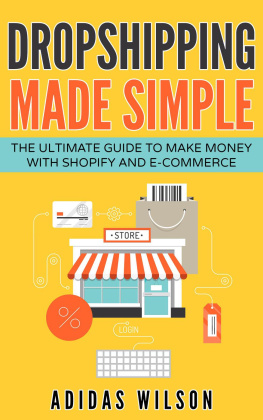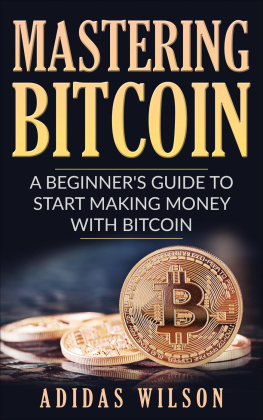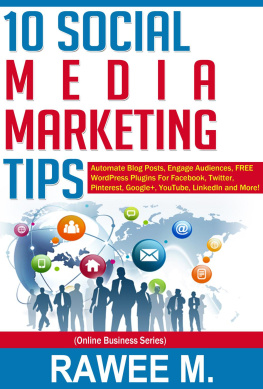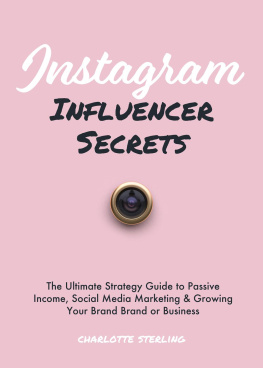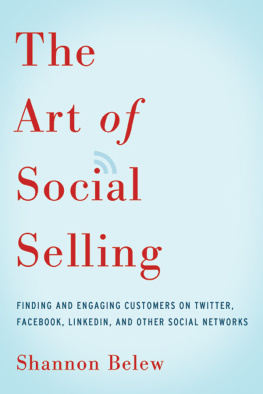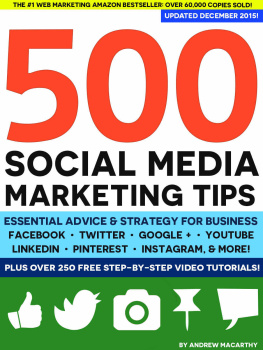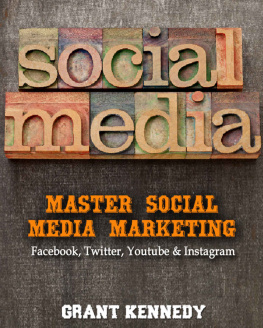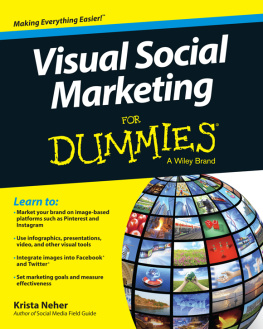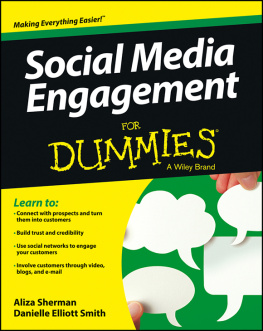Social Media Marketing - Ultimate User Guide to Facebook, Instagram, YouTube, Blogging, Twitter, LinkedIn, TikTok, Pinterest
Adidas Wilson
Published by Adidas Wilson, 2020.
Copyright 2020 by Adidas Wilson
All rights reserved. No part of this publication may be reproduced, distributed, or transmitted in any form or by any means, including photocopying, recording, or other electronic or mechanical methods, without the prior written permission of the publisher, except in the case of brief quotations embodied in critical reviews and certain other noncommercial uses permitted by copyright law. For permission requests, write to the publisher, addressed Attention: Permissions Coordinator, at the address below.
Adidas Wilson
P.O. Box 2266
Antioch, Tn. 37011
siriusvisionstudios@gmail.com
www.financierpro.com
I ntroduction
Facebook
Managing Your Facebook Business Page
Make Your Facebook Post Command Attention
Running Your Facebook Business Page
Video Marketing on Facebook
Definitive Guide to Marketing Your Business on Facebook
Facebook live Video for Your Business
Facebook for Marketing
Facebook Ads
Facebook Revenue for Entrepreneurs
Make Money Online (With Ads, Likes, Pages, and Apps)
Secrets to Facebook Success
Blogging
How to Make Money with Your Blog
How to Find a Blogging Niche
What Is Copywriting? Who Is a Copywriter?
How Much Does It Cost to Run a Blog?
How to Increase Blog Traffic
Ten Blog Characteristics and Quality Blog Post
How to Sell Ads on Your Blog
How to Sell Digital and Physical Products Online
100+ Types of Digital Content You Can Make
How to Sell Your Services Online
Tips That Guarantee More Blog Subscribers
What Is Evergreen Content and Why Your Blog Needs It?
Instagram
Marketing on Instagram
Instagram Stats
TikTok Marketing
How Can You Market on It
TikTok Algorithm
YouTube
The Complete Guide to YouTube Marketing
Pinterest
Pinterest for Business
LinkedIn Guide for Marketers
The Ultimate Twitter Marketing Guide
S ocial media marketing , simply explained, is using social media networks to drive website traffic, increase sales and build your brand by connecting with your audience. You do this by creating great content, interacting with your followers, running ads, and analyzing the results. Currently, the main social media platforms include Snapchat, YouTube, Pinterest, LinkedIn, Twitter, Instagram, and Facebook. Initially, social media marketing involved publishing. Businesses shared content on social media hoping to generate traffic and make sales. Today, it is more than that. Businesses now use social media in many other ways. Some of those ways include social media advertising, social media analytics and social media listening and engagement. Before you start publishing content on social media, you need to come up with a social media strategy. What do you want to achieve? How can you achieve your goals using social media? Your goals may be to increase brand awareness, drive website traffic, boost sales, create a community or generate engagement. Which social platforms will work for you? instead of trying to work with all platforms, it is better to pick a few ones. Find the ones that your target audience is likely to be on. What content will you be sharing? You could share entertaining or educating content. This will depend on your marketing persona. A consistent presence is especially important, especially for small businesses. Social media is used by about three billion people. Consistency increases the chances of these people discovering your business. On social media, publishing involves sharing a video, image, or blog post. It is not different from sharing using your personal account. But with a business account, the best thing to do would be to plan, instead of posting spontaneously. It is also wise to consider the type of content you publish, when to publish it and the frequency. Make good use of scheduling tools. Conversations about your business will increase as your following grows on social media. People will privately message you, tag you on their posts and engage with your content. Other times, there will be conversations about your business without your knowledge. And you must monitor these conversations. If the conversation is negative, you can correct it before it becomes a big problem. For this purpose, find a social media listening and engagement tool. It is important to know how your strategy is performing. Are you getting more positive comments? Are more people visiting your profile and interacting with your posts? Social media platforms offer this information, but only on the basic level. There are other social media analytics tools that you can use for in-depth information. If you have funds to spare, you can use social media advertising. The ads help you reach more people, beyond your following. The advertising platforms have become so powerfulyou can even choose who will see your ads. There are also advertising tools to help you manage the ads. Are you wondering what to opt for between paid and organic social media? Here is a quick answer: you may want to do both. Organic and paid social are used for different goals. If you want to balance conversion with awareness, you should know the advantages and disadvantages of both. People are using social media platforms more during the current pandemic. Ads spend, however, is not keeping up. Social media networks have reported revenue ups and downs. Many brands have paused advertising as a moral stance or because of the economic downturn. Everything is a little complicated now, but ad prices seem to be going down. So, which way should your social media marketing strategy lean? That depends on your goals. Organic Social Media includes the free content that you post on your feedstories, memes, videos, photos, and posts. When you post, the people that will see the content are: Some of your followers (this is your organic reach). Followers followers (when your followers share the post). If you use a hashtag, people who are following that hashtag. This may sound simple but organic social media is the best way to create a connection with your audience. It should be the foundation of every businesss marketing strategy. Organic social is used to: Offer customer service. Engage customers in their buying journey. Nurture relationships. Establish a brands voice and personality. Paid social media is advertising. Businesses pay money to social media platforms so their content can be shown to specific audiences. Paid social is used to: Drive conversions, generate leads, promote a new product, event, etc., and raise brand awareness. Paid vs organic social media has its own pros and cons. Check them out. Organic Social Media Pros - Convert new customers. Support existing customers. Establish the presence of your brand. It is free. Organic Social Media Cons takes time to get it right. Paid Social Media Pros - Reaches more people. You achieve your goals faster. You reach your target audience. Paid Social Media Cons - You need money. Requires some level of expertise. Most social media marketing strategies use organic social to engage existing customers and paid ads to attract new ones. All promotional posts do not have to be paid. A well-thought-out organic post can be just as powerful as a paid ad. Only opt for paid social if your organic social is not doing well. Promote your best organic content. If there is a post that existing customers seem to love, you can pay for new people to see it. Use A/B testing to optimize your posts. Your ads should be targeted to people who look like your organic audience. Maintain a connection with your organic audience using retargeting ads. Monitor your data to measure your results. This lets you know where you need to make changes. Make good use of automation.




